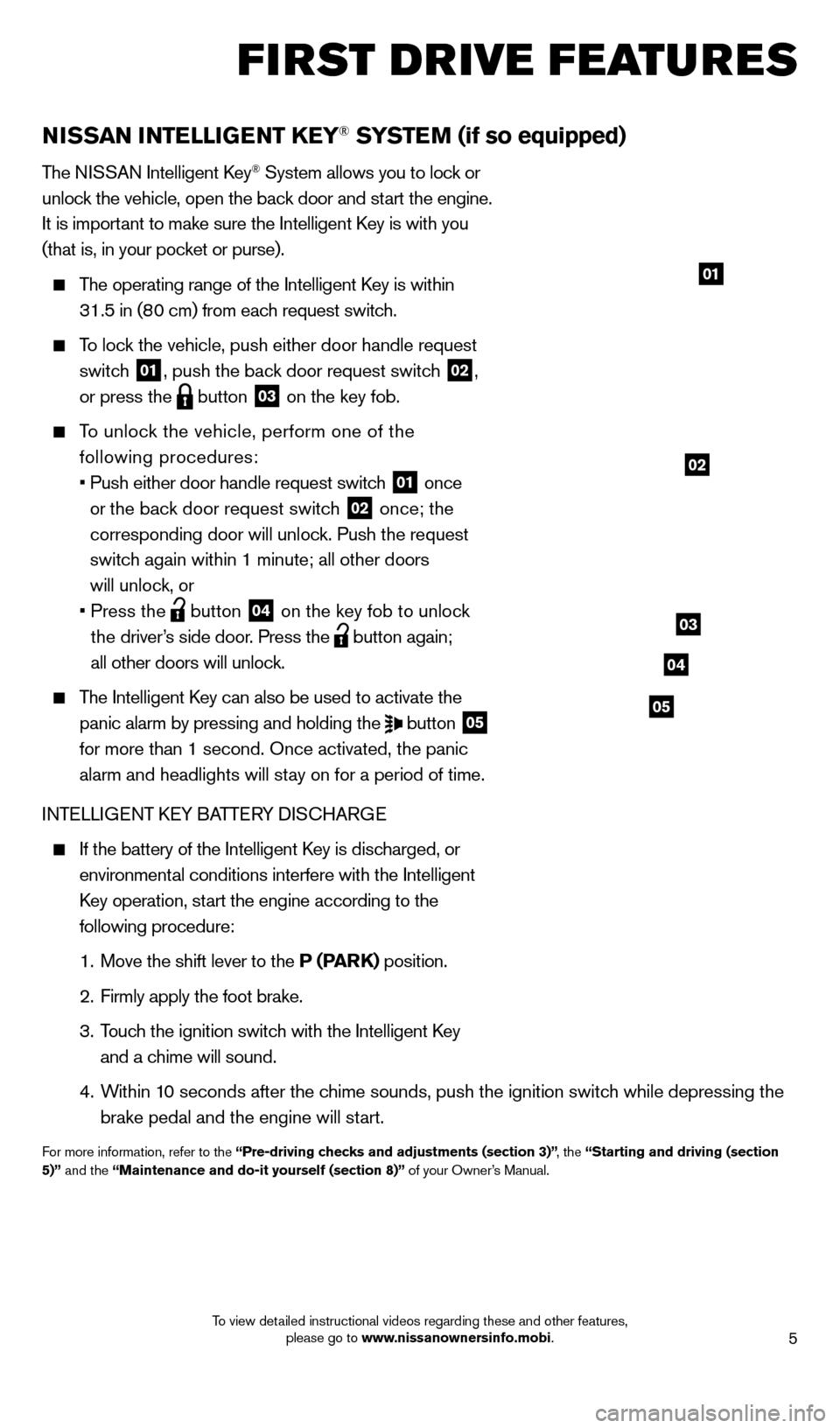maintenance NISSAN CUBE 2014 3.G Quick Reference Guide
[x] Cancel search | Manufacturer: NISSAN, Model Year: 2014, Model line: CUBE, Model: NISSAN CUBE 2014 3.GPages: 20, PDF Size: 1.16 MB
Page 5 of 20

3
esse ntial i n for mation
TIRE PRESSURE MONITORING SYSTEM (TPMS)
A CHECK… TIRE… PRES … warning message 01 will appear
as scrolling text in the trip computer display 02 and the low tire
pressure warning light 03 will illuminate when one or more tires
are low in pressure and air is needed.
•
T
he tire pressures should be checked when the tires are cold.
The tires are considered cold after the vehicle has been parked
for 3 hours or more or driven less than 1 mi (1.6 km) at
moderate speeds.
After tire pressures are adjusted, drive the vehicle at speeds
above 16 MPH (25 km/h). The CHECK... TIRE... PRES...
warning message and low tire pressure warning light
will disappear.
When the low tire pressure warning light flashes
for approximately 1 minute and then remains on, the
TPMS is not functioning properly. Have the system
checked by a NISSAN dealer.
Tire pressure rises and falls depending on the heat
caused by the vehicle’s operation and the outside temperature. Low
outside temperature can lower the temperature of the air inside the tire\
,
which can cause a lower tire inflation pressure. This may cause the low tire pressure warning
light to illuminate. If the warning light illuminates, check the tire pressure in your tires.
• Chec
k the tire pressures (including the spare tire) often and always prior to long distance trips.
The Tire and Loading Information label contains valuable information. Please refer to “Technical and consumer information” (section 9)”, in your Owner’s Manual for the location of the Tire
and Loading Information label.
For more information, refer to the “Instruments and controls (section 2)”, the “Starting and driving (section 5)” and the
“Maintenance and do-it-yourself (section 8)” of your Owner’s Manual.
01
02
03
LOOSE FUEL CAP
A LOOSE FUEL CAP warning message will appear
in the trip computer display
01 when the fuel-filler
cap is not tightened correctly.
To tighten, turn the cap clockwise until a single click
is heard.
The warning message will disappear when the vehicle
detects the fuel-filler cap is properly tightened and the
reset button
02 is pressed.
If the cap is not properly tightened, the Malfunction Indicator Light
may also illuminate.
For more information, refer to the “Instruments and controls (section 2)” and the “Pre-driving checks and adjustments
(section 3)” of your Owner’s Manual.
01
02
1523989_14_Cube_QRG_091613.indd 39/16/13 3:31 PM
To view detailed instructional videos regarding these and other features, please go to www.nissanownersinfo.mobi.
Page 7 of 20

5
NISSAN INTELLIGENT KEY® SYSTEM (if so equipped)
The NISSAN Intelligent key® System allows you to lock or
unlock the vehicle, open the back door and start the engine.
It is important to make sure the Intelligent
k
ey is with you
(that is, in your poc
ket or purse).
The operating range of the Intelligent key is within
31.5 in (80 cm) from each request switch.
To lock the vehicle, push either door handle request
switch
01, push the back door request switch 02,
or press the
button
03 on the key fob.
To unlock the vehicle, perform one of the
following procedures:
•
Push either door handle request switc
h
01 once
or the back door request switch 02 once; the
corresponding door will unlock. Push the request
switch again within 1 minute; all other doors
will unlock, or
•
Press the button
04 on the key fob to unlock
the driver’s side door. Press the button again;
all other doors will unlock.
The Intelligent key can also be used to activate the
panic alarm by pressing and holding the
button
05
for more than 1 second. Once activated, the panic
alarm and headlights will stay on for a period of time.
INTELLIGENT
k
EY BA
TTERY DIS
cHAR
GE
If the battery of the Intelligent key is disc harged, or
environmental conditions interfere with the Intelligent
key operation, st
art the engine according to the
following procedure:
1.
Move the shift lever to the
P (PARK) position.
2.
Firmly apply the foot brake.
3.
T
ouch the ignition switch with the Intelligent k
ey
and a chime will sound.
4.
W
ithin 10 seconds after the chime sounds, push the ignition switch while depressing the
brake pedal and the engine will start.
For more information, refer to the “Pre-driving checks and adjustments (section 3)” , the “Starting and driving (section
5)” and the “Maintenance and do-it yourself (section 8)” of your Owner’s Manual.
01
02
03
04
05
first drive features
1523989_14_Cube_QRG_091613.indd 59/16/13 3:31 PM
To view detailed instructional videos regarding these and other features, please go to www.nissanownersinfo.mobi.
Page 20 of 20

Nissan, the Nissan Brand Symbol, Z and
Nissan model names are Nissan trademarks.
©
2 0 13 Nissan North America, Inc.
QR14E 0Z12U0Printing: October 2013 (07)
To view detailed instructional videos,
go to www.nissanownersinfo.mobi/2014/cube
or snap this barcode with an appropriate barcode reader.
This Quick Reference Guide is intended to provide an overview of some of the uniq\
ue features of your new vehicle. See your
Owner’s Manual, which contains important safety warnings and information about the operation and maintenance of yo\
ur vehicle, for
complete details. Nissan North America, Inc. reserves the right to make changes, at any time, without prior notice, in prices, colors,
materials, equipment, specifications, and models and to discontinue mo\
dels or equipment. Due to continuous product development
and other pre- and post-production factors, actual vehicle, materials an\
d specifications may vary. Some vehicles are shown with
optional equipment. See the actual vehicle for complete accuracy. Specifications, options and accessories may differ in Hawaii, U.S.
territories and other countries. For additional information on availability, options or accessories, see your NISSAN dealer or contact
Nissan North America, Inc.
1523989_14_Cube_QRG_091613.indd 19/16/13 3:30 PM